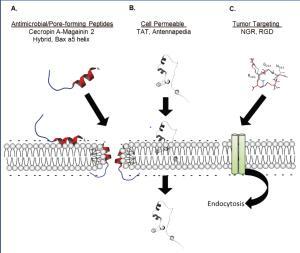
Peptide Targeting Cancer
Cancer is expected to surpass the current number one, cardiovascular diseases by 2030 as the leading cause of death.
The targeting peptides can be considered as an alternative vehicle for the delivery of anti-cancer drugs because of their lower molecular weight and excellent tolerability by human bodies.
The following modification can prolong the half-life of the peptides from the degradation by blood proteases: forming cyclization within a peptide, blocking of the C- and N- terminus, replacement of standard L-type amino acids by their D-amino acid counterparts, using unnatural amino acids incompatible with endogenous proteases.
About targeting peptides:
1. Somatostatin (SST) derivatives: Binding of the natural ligand somatostatin peptide to the receptors leads to inhibition of overexpressed SSTR2 and 5 in breast cancer. For example, cyclic SSTR agonist octreotide (fCfDWKTCT), selectively binds SSTR2 and 5.
2. Peptide-derivatives of gastrin-releasing peptide (GRP)
The gastrin-releasing peptide receptor is associated with the prostate and breast cancer. It was found that bombesin (YQRLGNQWAVGHLM) and its derivatives could be used as targeting peptides for the detection of prostate cancer via PET and CT screening.
3. Peptides targeting tumor microenvironment
The glycoprotein prosaposin (PSAP) can inhibit metastases from breast and lung cancer in preclinical models. A cyclic PSAP peptide (DWLPK) could hinder metastatic spread and restrain tumor development. The synthetic antagonist of CXCR4 called NT21MP (LGASWHRPDKCCLGYQKRPLP) exhibits anti-tumor activities through decreased adhesion and migration of breast cancer cells. The peptide R (RACRFFC) targeting of CXCR4, showed capacities to remodel the tumor stroma.
4. Peptides targeting the tumor pH and temperature
The pHLIP (pH-Low Insertion Peptide), ACEQNPIYWARYADWLFTTPLLLLDLALLVDADET, can be inserted into cell membranes as an a-helix under low pH conditions. The pHLIP peptide increases the uptake of the peptide-coated drug to tumors compared to the naked particles. Thus, the local tumor microenvironment can be used to trigger peptide drug formulations to respond accordingly.
The elastin-like polypeptides (ELP) are conjugated to the cell-penetrating peptide Bac (RRIRPRPPRLPRPRPRPLPFPRPG) for improved cellular penetration to deliver gemcitabine for pancreatic cancer.
5. Peptides targeting tumor tissues
A widely used endothelial-binding peptide is The tripeptide arginine-glycine-aspartic acid (RGD), an endothelial-binding peptide, that has high specificity towards integrins for anti-tumor and anti-angiogenic treatments.
The radiolabeled, PEGylated RGD has been used as a PET probe to detect gliomas, and the iron-oxide nanoparticles coupled RGD was used for the MR imaging of brain tumors.
The cyclic iRGD (CRGDKGPDC) is a prototypic tumor-penetrating peptide binding integrins. The iRGD peptide increased tumor tissue penetration and the delivery of drugs, nanoparticles, or antibodies in vivo.
The cRGD (RGDdYK) and cilengitide (cRGDf [N-Me]V) with the combination therapy of temozolomide (TMZ) radiochemotherapy were used in the clinical trials.
A linear targeting peptide called CooP (CGLSGLGVA) binds the mammary-derived growth inhibitor (MDGI). The MDGI is a fatty acid-binding protein that is highly expressed at the cell membrane of malignant glioma cells.
The coop peptide is a homing peptide targeting glioma cells and tumor-associated blood vessels. The chemotherapeutic drug conjugated CooP peptide can reduce the number of invasive tumor cells.
The cell penetration peptides are the cure for difficult-to-access cancers such as brain tumors. This endothelial-specific peptide with enhanced penetrance would allow better passage of the drug conjugates through the blood-brain barrier.
The peptide drugs have the benefits of high specificity, low antigenicity, low cost, and simple production. The peptides have the potential for the development of therapy options for various tumors in the field of personalized medicine of cancer.

Cell-penetration-peptides
